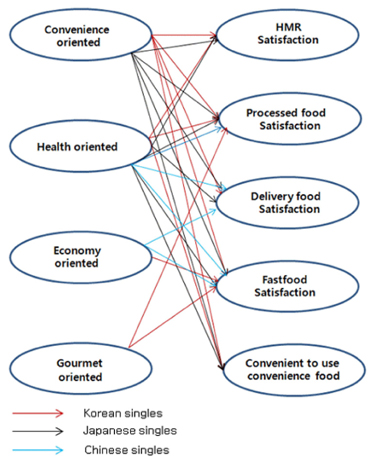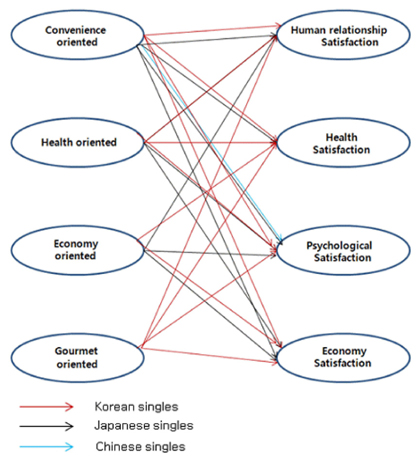Nutr Res Pract.
2014 Jun;8(3):312-318.
Structural relations in the effect of convenience food satisfaction and quality of life according to dietary style: Comparative study of singles in metropolitan area of Korea, Japan and China
- Affiliations
-
- 1Department of Food and Nutrition, Sookmyung Women's University, 100 Cheongpa-ro 47-gil, Yongsan-gu, Seoul 140-742, Korea. namij@sookmyung.ac.kr
Abstract
- BACKGROUND/OBJECTIVES
Due to recent changes in social structure, single-person households are on the rise worldwide and therefore the interest in the quality of life of singles is increasing, but the research on the relationships related to their diet-related quality of life is scarce. This research analyzes the structural relations in the effect of convenience food satisfaction and quality of life according to dietary style of Korean, Japanese and Chinese singles.
SUBJECTS/METHODS
The targets of this study were Korean, Japanese, and Chinese singles, identified as adults between the ages of 25 and 54, having economic capabilities or working and living alone, either legally or in actuality having no partner. A statistical analysis was conducted using SPSS12.0 for Windows and SEM using AMOS 5.0 statistics package. The reliability of these findings was supported by a Cronbach's alpha coefficient of 0.6 and higher for all the factors. In an attempt to study the level of satisfaction with convenience food in accordance to dietary style and the quality of life of singles, a structural equation model was constructed and analyzed.
RESULTS
Of the three countries, regarding the effect of dietary style on singles' quality of life, the convenience-oriented style was found to have a negative effect on Korean singles' overall quality of life, but a positive effect on Japanese singles' overall quality of life, and a negative effect on Chinese singles' positive psychological aspect of quality of life. In addition, although Chinese singles have a high level of interest in health, they have an overall high level of satisfaction regarding fast food and its nutritional value.
CONCLUSIONS
The number of singles in Korea, Japan, and China has been consistently increasing in recent years, and there is a need for continuous interest in their healthy dietary lifestyles in terms of convenience, economy, and taste.
MeSH Terms
Figure
Reference
-
1. Hall R, Ogden PE, Hill C. The pattern and structure of one-person households in England and Wales and France. Int J Popul Geogr. 1997; 3:161–181.
Article2. Mulder CH. The effects of singlehood and cohabitation on the transition to parenthood in the Netherlands. J Fam Issues. 2003; 24:291–313.
Article3. Statistics Korea. Population and Housing Census. Daejeon: Statistics Korea;2007.4. Statistics Korea. Population and Housing Census. Daejeon: Statistics Korea;2010.5. Statistics Japan. Population and Housing Census. Tokyo: Statistics Japan;2007.6. National Bureau of Statistics of China. Fifth National Population Census of the People's Republic of China. Beijing: National Bureau of Statistics of China;2010.7. Stockman NK, Schenkel TC, Brown JN, Duncan AM. Comparison of energy and nutrient intakes among meals and snacks of adolescent males. Prev Med. 2005; 41:203–210.
Article8. Lee SM. The status of meal delivery programs and the study of homebound senior's meal satisfaction related to development of quality of life construct model [doctor's thesis]. Seoul: Sookmyung Women's University;2011.9. Ryan I, Cowan C, McCarthy M, O'Sullivan C. Segmenting Irish food consumers using the food-related lifestyle instrument. J Int Food Agribus Mark. 2004; 16:89–114.
Article10. O'Sullivan C, Scholderer J, Cowan C. Measurement equivalence of the food related lifestyle instrument (FRL) in Ireland and Great Britain. Food Qual Prefer. 2005; 16:1–12.11. Seung HS. A study on using behavior of bakery by dietary lifestyle [master's thesis]. Seoul: Ewha Womans University;2005.12. Lim YM. A study on the food-related life style to wine selection attribution [master's thesis]. Seoul: Kyung Hee University;2006.13. Moon YS. A study on the green tea consumption behaviors depending on the food-related lifestyle [master's thesis]. Seoul: Sungkyunkwan University;2012.14. Chung LN. Analysis of consumer inclination to convenience towards home meal replacement in Korea [doctor's thesis]. Seoul: Yonsei University;2005.15. Park SN. A comparative study for HMR: what is the theory that especially 20-30 adults South Korea and Japan? [master's thesis]. Seoul: Kyonggi University;2007.16. Lee HW. Consumers attitude toward rice processed foods based on food-related lifestyle [master's thesis]. Seoul: Yonsei University;2010.17. Choi SG. A study of singles' dining-out behavior and food consumption behavior by the lifestyle [master's thesis]. Seoul: Sangmyung University;2011.18. Ro YJ. An analytical study on the quality of life of the middle-aged in Seoul [doctor's thesis]. Seoul: Yonsei University;1988.19. Oh WK. A study on the HMR(Home Meal Replacement) marketing strategy of dietary life style through analysis [master's thesis]. Seoul: Kyonggi University;2008.20. Hong SK. A study on processed food purchasing behavior and satisfaction according to the urban housewives' food-related lifestyle [doctor's thesis]. Seoul: Kyonggi University;2011.21. Noh WH, Ahn SH, Yang LL, Song YW. The influence of consumption value towards attitude and purchase intention perceived by Chinese consumers in the context of healthy functional foods. Korean Chin Stud Soc Sci. 2012; 23:179–206.22. Yu DH. A study on the management strategies for the successful food service franchise business in China [doctor's thesis]. Busan: Dong-A University;2009.23. Kim MJ. A survey on changes in quality of life of patients who received radiation therapy after surgery for breast cancer. J Nurs Acad Soc. 1994; 24:652–665.
Article24. Kim MK. A study of relationship between health promoting behavior indices and quality of life indices [master's thesis]. Seoul: Yonsei University;2001.25. Kim SJ. A study of relationship between health promoting lifestyle, depression, quality of life among middle aged women [master's thesis]. Suwon: Ajou University;2007.
- Full Text Links
- Actions
-
Cited
- CITED
-
- Close
- Share
- Similar articles
-
- Structural relations of convenience food satisfaction and quality of life according to dietary style: Focusing on singles in metropolitan area of Korea
- Causal relationship among quality factors, emotional responses, and satisfaction of school food service in Henan province, China
- An Evaluation on the Attitudes and Importance-Satisfaction on Service Quality of University Foodservice among International Students in Busan
- Grandmother's Life Satisfaction and Influencing Factors by Grandparenting
- The differences of dietary behaviors, dietary life consumer education related current situations · competencies and dietary lifestyles between baby-boom and echo generations





